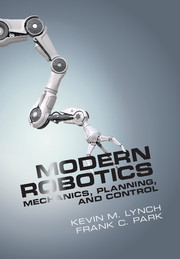Book contents
- Frontmatter
- Contents
- Foreword by Roger Brockett
- Foreword by Matthew Mason
- Preface
- 1 Preview
- 2 Configuration Space
- 3 Rigid-Body Motions
- 4 Forward Kinematics
- 5 Velocity Kinematics and Statics
- 6 Inverse Kinematics
- 7 Kinematics of Closed Chains
- 8 Dynamics of Open Chains
- 9 Trajectory Generation
- 10 Motion Planning
- 11 Robot Control
- 12 Grasping and Manipulation
- 13 Wheeled Mobile Robots
- A Summary of Useful Formulas
- B Other Representations of Rotations
- C Denavit–Hartenberg Parameters
- D Optimization and Lagrange Multipliers
- Bibliography
- Index
C - Denavit–Hartenberg Parameters
Published online by Cambridge University Press: 04 June 2024
- Frontmatter
- Contents
- Foreword by Roger Brockett
- Foreword by Matthew Mason
- Preface
- 1 Preview
- 2 Configuration Space
- 3 Rigid-Body Motions
- 4 Forward Kinematics
- 5 Velocity Kinematics and Statics
- 6 Inverse Kinematics
- 7 Kinematics of Closed Chains
- 8 Dynamics of Open Chains
- 9 Trajectory Generation
- 10 Motion Planning
- 11 Robot Control
- 12 Grasping and Manipulation
- 13 Wheeled Mobile Robots
- A Summary of Useful Formulas
- B Other Representations of Rotations
- C Denavit–Hartenberg Parameters
- D Optimization and Lagrange Multipliers
- Bibliography
- Index
Summary
The basic idea underlying the Denavit–Hartenberg approach to forward kinematics is to attach reference frames to each link of the open chain and then to derive the forward kinematics from the knowledge of the relative displacements between adjacent link frames. Assume that a fixed reference frame has been established and that a reference frame (the end-effector frame) has been attached to some point on the last link of the open chain. For a chain consisting of n onedegree- of-freedom joints, the links are numbered sequentially from 0 to n: the ground link is labeled 0, and the end-effector frame is attached to link n. Reference frames attached to the links are also correspondingly labeled from ﹛0﹜ (the fixed frame) to ﹛n﹜ (the end-effector frame). The joint variable corresponding to the ith joint is denoted θi. The forward kinematics of the n-link open chain can then be expressed as
where Ti,i−1 ϵ SE(3) denotes the relative displacement between link frames ﹛i − 1﹜ and ﹛i﹜. Depending on how the link reference frames have been chosen, each Ti−1,i can be obtained in a straightforward fashion.
Assigning Link Frames Rather than attaching reference frames to each link in an arbitrary fashion, in the Denavit–Hartenberg convention a set of rules for assigning link frames is observed. Figure C.1 illustrates the frame-assignment convention for two adjacent revolute joints i − 1 and i that are connected by link i − 1.
The first rule is that the ẑi-axis coincides with joint axis i and the ẑi−1-axis coincides with joint axis i−1. The direction of positive rotation about each link's ẑ-axis is determined by the right-hand rule.
Once the ẑ-axis-direction has been assigned, the next rule determines the origin of the link reference frame. First, find the line segment that orthogonally intersects both the joint axes ẑi−1 and ẑi. For now let us assume that this line segment is unique; the case where it is not unique (i.e., when the two joint axes are parallel), or fails to exist (i.e., when the two joint axes intersect), is addressed later.
- Type
- Chapter
- Information
- Modern RoboticsMechanics, Planning, and Control, pp. 506 - 515Publisher: Cambridge University PressPrint publication year: 2017

